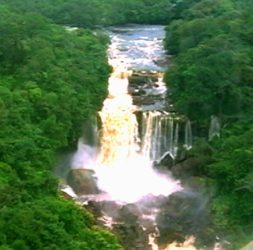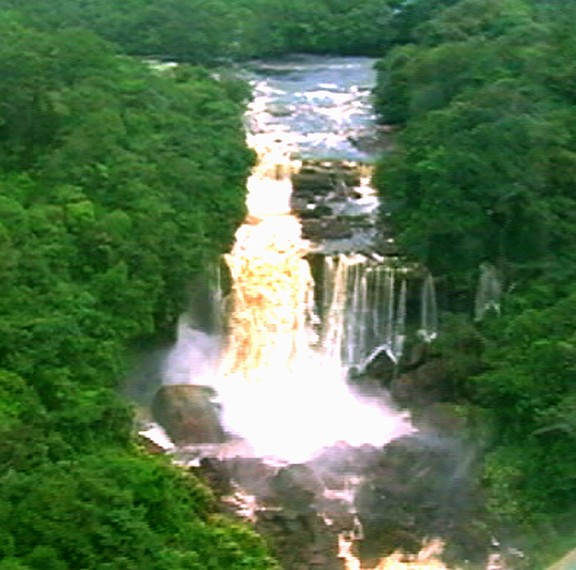The government today released the final report on the feasibility of the Amaila Falls Hydropower Project and the project now appears to be off the table as a number of risks have been pointed out by the author, Norconsult.
A statement from the Ministry of the Presidency follows:
Guyana’s long term energy plan for the transition to the increased use of renewable energy is expected to be presented to Cabinet by mid-January. Minister of Public Infrastructure, Mr. David Patterson, in an invited comment, earlier today, said that “final touches are being made to the draft document” and once Cabinet has had their input, it will be released to the wider public. He also noted that the Government is committed to exploring all avenues for the development of renewable energy in keeping with its ‘green’ development agenda.
This comes even as the Government of Norway has released the report on the review of the Amaila Falls Hydropower Project (AFHP) done by Norconsult, an engineering and design consultancy firm out of Norway contracted by the Government of Norway to complete an ‘objective and facts-based’ assessment of the project on the agreement of two Governments.
Though the project is just one of several renewable energy options being looked at by Guyana, Government believes that the Report identifies several risks and flaws in the design of the project, which will threaten its long-term effectiveness and prove too costly and burdensome to the people of Guyana and the country as a small developing state.

The Government considers this review of utmost importance as it provides indisputable evidence to support the position taken while in opposition that the Hydropower project in its current configuration does not meet minimum requirements to ensure its viability and longevity. It is the view of the Government that the Norconsult Report has given credence to its position on the need for an energy mix to increase the country’s share of renewable energy by close to 100 percent by the year 2025. The Report also provides supporting evidence that the Amaila Falls Hydropower Project would not be optimal in its current model and presents an unbalanced risk to the Government and People of Guyana.
Rectifying the many issues identified will increase the total cost of the project substantially, thereby impacting the tariff rates from the outset. Additionally, there are at least six more years of work to be completed, including a minimum three years of water flow study and analysis on the project.
Having studied the Report and conscious of the specific needs of the country, the Government of Guyana proposes to utilise a mix of energy options, starting with less risky options such as solar and wind, as outlined in Budget 2017.
Provisions have been made for expansion of the scope of clean, alternative energy in the country resulting in more reliable electricity supply; the establishment of programmes to promote energy efficiency at a household level for financial savings to householders; budgetary allocations of almost $1 billion dollars for renewable energy and energy efficiency projects; the installation of solar photovoltaic (PV) systems on the rooftops of 64 Government buildings; the installation of a large scale solar farm in Mabaruma with smaller solar farms in Lethem, Mahdia and Bartica; a one off tax holiday concession of two years for corporation tax to the business community for the importation of items related to wind and solar energy investments, water treatment, waste disposal and recycling facilities and the replacement of inefficient lights with their energy efficient counterparts.
Itemised below are some of the risks and flaws identified in the report:
- The absence of a separate flywheel between the turbine and the generator. This is described by Norconsult as a highly uncommon design and impractical for vertical shaft units of a size as in the case of AFHP. This requirement is also notably absent from the Engineering/Procurement/Construction (EPC) Contract drawings, the technical description of the project, the Bill of Quantities and in the Independent Engineer’s Due Diligence Report of 2013.
- While the report acknowledges the existence of an escarpment just beyond the midway point of the tunnel routing alignment, creating a horizontal distance of about 1.2 km from the vertical pressure shaft inside the mountain ridge to the powerhouse at the end of the tunnel, this configuration has resulted in the pressure shaft and pressure tunnel being quite expensive plant components. The report goes on to state “Considering the longitudinal profile of the waterway and apparent suitable rock conditions, we find it surprising that an underground powerhouse is not mentioned anywhere as a project layout alternative”. This observation is also supported by a short note in the Independent Engineer’s (IE) report, which stated that more usually a powerhouse underground would have been expected under natural conditions as encountered at Amaila Falls.
- Norconsult report further identifies the absence of several details from the Owner’s requirement including the “minimum requirement to overall plant efficiency, which includes the hydraulic losses in the waterway”. A major headache for the project is identified in the statement “The power plant is required to yield a certain output (MW) at a certain headwater level with no maximum figure set for the corresponding turbine water flow. Therefore the EPC Contractor could chose to diminish the cross area (diameter) of the tunnels in order to save cost and compensate by increasing the water flow. This would mean less energy production of the same amount of water and thereby a less efficient utilisation of the Amaila Falls as a hydropower resource.”
- Norconsult further points out that “19 m head loss in about 3 km long headrace tunnel is higher than would be expected for a hydropower plant designed by traditional procedures for hydraulic optimisation”. The report goes on to state that “the dimensions described for the pressure shaft and pressure tunnel are also not sufficient for satisfying requirements for regulation stability”.
- Norconsult further notes the absence of any sediment handling methodology in the design of the plant. This is quite a serious issue since sedimentation can threaten the plant’s continued operation.
- Norconsult also questions the steel lining proposed for the tunnel lining and notes that risks associated with this configuration can be reduced by an “expensive vertical core drilling from the surface and down the hole hydraulic splitting tests at different levels in the holes” or “Alternatively, the risk could be eliminated by assuming steel lining in the whole length from the powerhouse up to the top of the pressure shaft with a substantial additional cost, which would then be reflected in the tariff from the beginning.”
- The report clearly establishes that the overall project layout chosen as the “Owner’s Requirement” for the EPC Contract may not be the optimum solution for the project. This is particularly informed by the report finding of absence of “any indication in the project material that these layouts have been compared with an alternative underground powerhouse location, which could eliminate the frequency stability problem and give substantial cost saving for the tunnel system and the generating units.”
- The analyses of other renewable energy alternatives considered biomass, PV and wind projects. Biomass while much cheaper at 4.4UScents/kWH which require clearing of large areas of forest since sufficient biomass is unavailable otherwise. The report further states “PV solar and wind projects were at the time more expensive than Amaila Falls with unit costs of 26 and 14 USc/kWh, respectively. However, recent projects in other developing countries have shown that the cost of PV solar and wind projects have dropped significantly and may now be more competitive (as part of energy mix) but from a system point of view, solar power is not sufficiently stable and can therefore not be recommended as the main source of power in the main grid. Solar may be used in off-grid areas with battery back-up and or in the main grid for generation during day-time, but it cannot function as source for base load power.”


